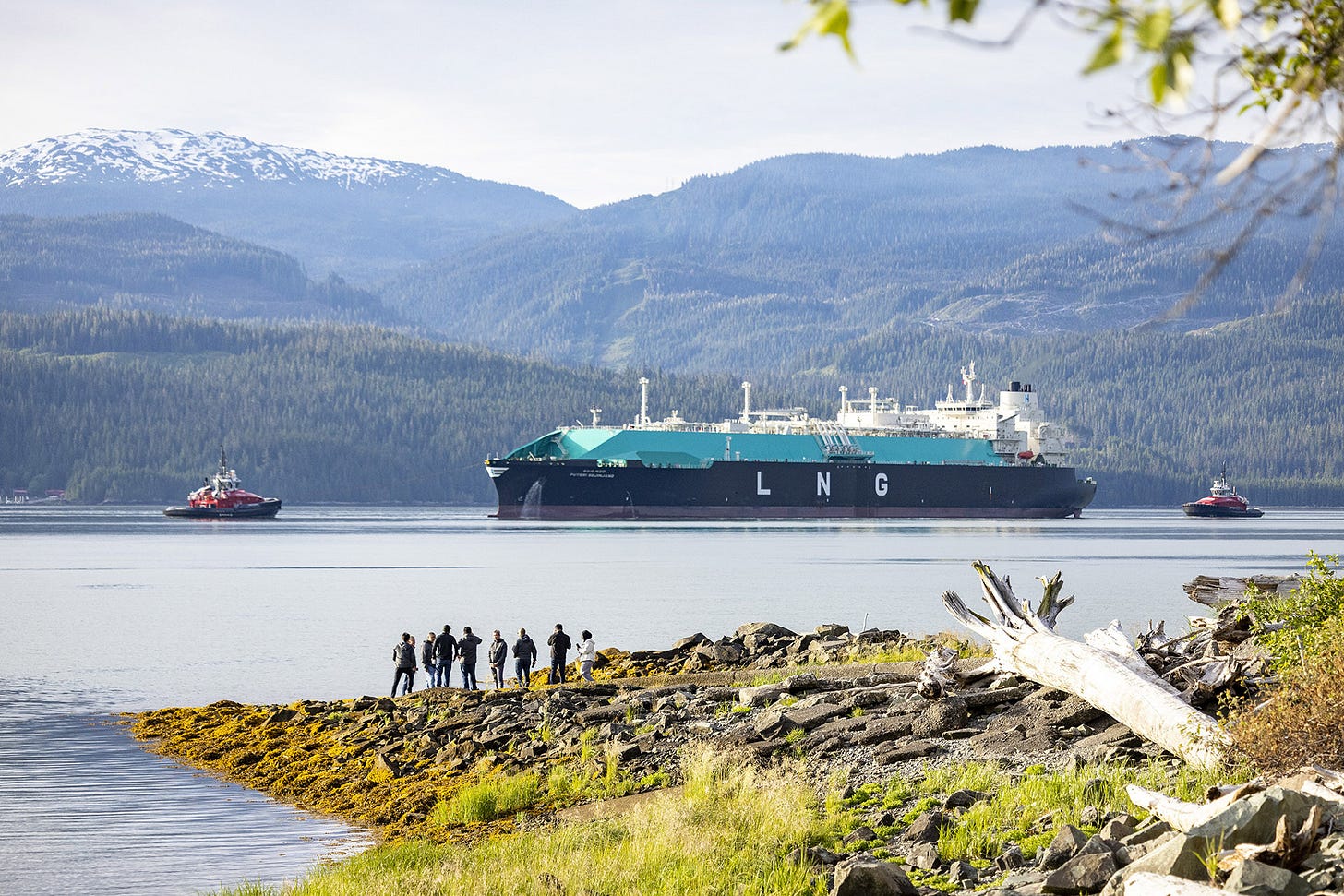Canada Begins Piping LNG to Asia as Ottawa Trumpets Diversification
See data and commentary on how liquid natural gas is set to divert from south of the border and directly to China
This week’s Canada-China Brief offers exclusive insight:
Turning the taps: See how Ottawa is embracing LNG Canada’s opening with LNG set for China and other Asian economies and away from the U.S.
Data Dive: Key numbers, charts, and analysis including how LNG exports are positioned to grow Canada’s global market share
Expert voices: New analysis from experts in both Canada and China sheds light on a full view of world events
Starting this week, more of our data analysis and special commentary will be placed below the paywall. We encourage you to subscribe for just $5/month or $50/year to access the full analysis, stay ahead of the curve on Canada-China relations, and support independent, policy-driven coverage that gives you the full picture beyond the headlines.
Data Dive
What’s next below the paywall:
Data analysis of Canada’s global LNG export capacity before and after LNG Canada’s pipeline opening
Big picture view into China’s role as the world’s largest LNG import market
Cost comparison of how Canadian LNG shipped to Asia from BC outcompetes U.S. competition
IPD highlights the numbers that matter. See more data analysis below the paywall cut by subscribing now for just $5 a month.
Top Story
LNG Canada Comes Online as First Shipments Sail for Asia
Redirection underway — The $40 billion project’s phase one operations began this week as Canadian liquid natural gas is set for Japan, China, South Korea, and Malaysia:
The pipeline and terminal pave a new path as the country’s LNG exports have until now been routed almost entirely south of the border, with British Columbia Premier David Eby stating that “it’s more important than ever that we get our resources to global markets and reduce our reliance on the United States.“
Echoing Eby, Prime Minister Mark Carney noted that “with LNG Canada’s first shipment to Asia, Canada is exporting its energy to reliable partners, diversifying trade, and reducing global emissions” and that “Canada can become the world’s leading energy superpower with the strongest economy in the G7.”
Zhiyong Liu, CEO of PetroChina — which holds a 15% stake in LNG Canada — said that the company is “proud to be a joint venture participant in this major milestone for Canada’s energy industry and the global energy transition” as it will “play a vital role in stabilizing global energy supply.”
Shamsairi Ibrahim, a Vice President of Petronas which holds 25% of LNG Canada, touted the project as part of its efforts to internationalize its sources to serve the Chinese market, with the new BC terminal part of “broadening our supply network, particularly in North America.”
International Trade Minister Maninder Sidhu recently observed an openness to addressing Canada-China issues, saying “we'll continue building on that. But the first part is to have those conversations being started… diplomacy can do wonders and we need to make sure that we're able to have those conversations.”
What’s next below the paywall:
Headline statistics on China’s emergence as Canada’s largest oil buyer, surpassing the United States
Narrowing price gap between Canadian and American oil exports after the opening of the Trans Mountain pipeline
Shorter shipping advantage of Canadian crude over U.S. competition exported to Asia
From the Experts
IPD brings what scholars and opinion leaders in China and Canada have to say on the challenges both countries face.
The Word in China
Li Yalan
Immediate Past President, International Gas Union | READ
The global LNG market equilibrium is fragile and sensitive to uncertainties from both supply and demand sides. In addition to these market and project dynamics, considerable uncertainty in geopolitics, trade, and regulatory policy characterises today’s energy landscape…
Growing demand for natural gas in emerging markets, the increasing diversification of market participants, the expansion of infrastructure, and the development of innovative technology will all continue to drive the LNG market… LNG is an invaluable tool that continues to gain traction as an affordable and reliable option for growing energy markets looking to displace higher-emitting fuels.
What’s next below the paywall:
Wen Jing: Assistant Research Fellow, Center for International Security and Strategy, Tsinghua University
Zhao Quansheng: Professor and Chair, Asian Studies Research Council, American University
Tang Dexin: Research Fellow, Korea-China Economic Development Research Institute
See more Chinese commentary below the paywall cut by subscribing now for just $5 a month.
The Word in Canada
On new energy exports to Asia, economic diversification, and future policy:
Rachel Ziemba
Adjunct Senior Fellow, Energy, Economics, and Security Program, Center for a New American Security
LNG Canada’s first shipment is an important step in Canada’s export diversification, providing a clearer path to send LNG to Asia, where the structural demand lies. Along with the TMX extension for oil, it leaves Canadian fuel producers less reliant on US egress routes and could allow greater revenues. In the next year, export capacity is likely to rise to close to 2bcf/day and other projects including Cedar LNG will add small additional amounts. Canadian supplies benefit from a shorter distance to market than their major competitors in the U.S. Gulf Coast — 20 fewer days to South Korea, the first cargo purchaser.
After a long -production cycle, these projects show also the infrastructure that goes ahead will have indigenous beneficiaries among the ownership groups and needs commitment from provincial, federal and local authorities.
Scaling capacity further will be more difficult. Projects will take many years however and would face competition from significant planned volume increases in Qatari and US production, all of which are also targeting the Asian market. Asian buyers are increasingly price sensitive about LNG, especially new buyers like India and Pakistan but also China. Overall, many Asian countries are relying more on incremental volumes of coal as well as renewable power for their burgeoning power needs. This suggests Canadian producers may need to be realistic about the competition ahead and the likely export price demand. There seems to be more political consensus around LNG export infrastructure than oil, but further developments will be a key test of the Carney government’s commitment to be an energy superpower. These projects take time and have costs and maintaining political commitment is key.
Additional LNG export capacity does help diversify Canada’s exports of fuel, but it could increase local prices for natural gas which has been beneficial for some industry especially in Alberta.
Elmira Aliakbari
Director, Natural Resource Studies, Fraser Institute
In a recent study, we analyzed Canada’s contribution to reducing global GHG emissions by exporting its LNG and helping countries in Asia become less reliant on much more carbon-intensive fuels such as coal. We found that doubling Canadian natural gas production and exporting the additional supply to Asia in the form of LNG to replace coal-fired power could reduce global emissions by up to 630 million tonnes annually, which is the equivalent of removing approximately 137 million cars from the road. So, by displacing coal in Asia, Canadian LNG can play a significant role in cutting total global emissions even if domestic emissions were to increase.
However, regulatory uncertainty and a range of federal and provincial barriers continue to hinder LNG development in the country. For instance, the federal government’s Impact Assessment Act, introduced in 2019 with the intention of streamlining project approvals, has instead created more uncertainty and complexity in the review process. In addition, the federal government’s GHG cap imposed on the oil and gas sector is another top policy barrier to unlocking the country’s LNG potential. At the provincial level, British Columbia’s CleanBC regulations — which place a cap on GHG emissions from the oil and gas sector and require all new LNG projects to have a plan to reach net zero by 2050 — are another barrier.
Wenran Jiang
President, Canada-China Energy & Environment Forum; Advisor, Institute for Peace & Diplomacy; Founding Director, China Institute and Mactaggart Research Chair Emeritus, University of Alberta
Canada has long relied solely on the U.S. market for its energy export, creating a total dependency. Now, with Trump’s trade war against all, including Canada, diversification has become a priority. Canada has one of the best natural gas reserves in the world, and its LNG potential is very promising. By exporting large volumes of LNG to Asia, Canada can diversify its market, get much better economic return, and most importantly, Canadian LNG may replace coal use in East Asian countries, leading to immediate emission reductions globally.
LNG Canada’s first shipment of LNG to Asia has marked the first critical step of Canadian LNG going global. With 14 million tonnes of annual production, with potential phase 2 of the project doubling that amount to 28 million tonnes per year, Canada has finally joined the global LNG exporting club, competing with the US, Australia, Qatar and others. LNG Canada, together with its Asia-based JV partners, has shown that large projects can be both economically viable and environmentally friendly. With LNG Canada in production, it has a demonstration effects to other ongoing LNG projects, such as Woodfibre LNG, Cedar LNG and Ksi Lisims LNG projects.
LNG Canada is actively working on the Phase 2 of its LNG project. Given the smoothly production and delivery of its first LNG cargo, we may expect the focus to shift to Phase 2 final investment decision. Facing Trump’s trade war, the strategic and economic benefits for an expanded LNG industry in Canada today are very clear. The recent passing of Bill C-5, the One Canadian Economy Act ,signals positive development for big LNG projects. But much is depending on the overall policy framework of the new Liberal government led by Prime Minister Mark Carney, who has repeatedly claimed to make Canada an “energy superpower.” The BC government will also play a key role in shaping the policy environment for LNG Canada Phase 2 and other LNG projects to proceed.
Thanks for reading the Canada-China Brief from the Institute for Peace & Diplomacy! Join a free trial now for full access to Data Dive and The Word in China coverage below, including extended data analysis and translated expert commentary
Keep reading with a 7-day free trial
Subscribe to Canada-China Brief to keep reading this post and get 7 days of free access to the full post archives.








